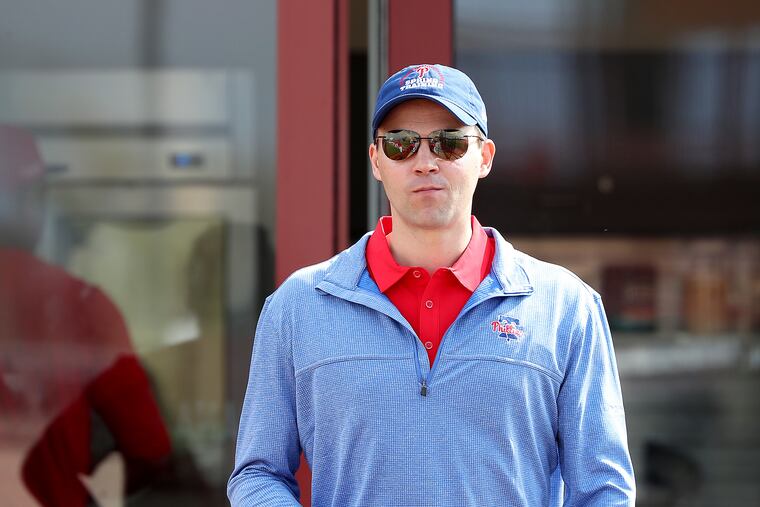Matt Klentak says Phillies ‘absolutely’ have enough pitching
The Phillies have 40 pitchers in camp, but they still have questions in their rotation and bullpen.

CLEARWATER, Fla. — The last remaining locker in the Phillies’ spring-training clubhouse was claimed earlier this week, when a team official placed Tommy Hunter’s nameplate above the stall adjacent to Jake Arrieta’s locker.
The Phillies have 71 lockers in their clubhouse, and all 71 are claimed. They have been coming to Clearwater for 73 years, but they’ve likely never started spring training with more players than this.
“And that’s by design,” general manager Matt Klentak said at a Thursday morning news conference.
The Phillies have 40 pitchers in camp, which is why space is at a premium in the clubhouse at Spectrum Field. They have 10 more pitchers than they did last year. Yet, they still begin spring training with uncertainty at the back of their starting rotation and even more questions in the bullpen.
Klentak signed Zack Wheeler to a $118 million contract in December, but did not sign another pitcher to a major-league deal until Hunter signed Wednesday for less than $1 million. Instead, the Phillies looked internally to complete their starting rotation and invited six veteran relievers to camp on minor-league contracts.
The Phillies have enough pitchers to run out of lockers, but they still might not have enough arms.
“I absolutely think we have enough starting pitching and bullpen pitching to compete,” Klentak said.
The Phillies this week were given a 5.1% chance to make the playoffs by Baseball Prospectus, which was particularly down on the team’s bullpen and starting pitchers not named Wheeler and Aaron Nola. Their path to the postseason will be greatly decided by pitching, just as it was last season, and by the decisions of the front office that constructed a rotation and bullpen filled with uncertainty.
But for all the volatility at the back of the rotation, the Phillies do have stability at the top with Nola and Wheeler, who will turn 30 in May and posted a 2.83 ERA with the Mets after last season’s All-Star break. The Phillies could have eased some concerns by acquiring an additional starter this winter, but they opted against it as they neared the luxury-tax threshold.
So the Phillies will hope that the surgery Jake Arrieta underwent last summer to remove a bone spur from his elbow can return him to being a dependable starter. They’ll hope Zach Eflin can pitch an entire season the way he finished 2019, when he had a 2.83 ERA in his final seven starts. They’ll bet again on Nick Pivetta and Vince Velasquez, who disappointed last season but will compete this spring for the final rotation spot.
And they’ll hope that pitching coach Bryan Price, hired to replace the analytically driven Chris Young, can use his years of experience to tap into the potential that Eflin, Pivetta, and Velasquez have shown.
“Sometimes, players respond differently to different messengers and messages,” Klentak said. “I think bringing in an experienced manager and experienced pitching coach, specifically, will be very helpful to what is still in a lot of respects a young and improving major-league pitching staff. I don’t think we’re going to focus less on analytics, but I do think we’re going to see some changes in the way that that information is communicated, and I’m hoping that will have a positive effect on a bunch of these guys.”
But if the back of the rotation stumbles, the organization’s pitching depth will be tested. The Phillies will take a look this spring at Cole Irvin and will stretch out Ranger Suarez, after he spent last season as a reliever, but the team does not have a stable of starters waiting for a chance. They’ll dream about Spencer Howard and Damon Jones, but both prospects will begin the season at triple A, and Howard will be constrained by an innings limit.
The Phillies not only need to determine who their fifth starter is, but who would be their sixth and seventh choices if a need arises.
“I believe we can put together a back of a rotation with guys we have or players we could potentially acquire later if we need to," Klentak said. "To add a front-of-the-rotation guy is really hard. That’s why we targeted Zack Wheeler as we did.
"In doing so, that really creates additional depth for you from a top-down perspective. It pushes some other guys into more-comfortable roles. We still do believe that Nick Pivetta has a big jump in him. We believe that Spencer Howard, at some point in the coming year, is going to impact our major-league club.”
The makeup of bullpen seems to be an even bigger mystery. Hunter, Adam Morgan, Victor Arano, and Seranthony Dominguez could be four of the team’s eight relievers, but each of them ended last season on the injured list.
The Phillies invested $56 million on free-agent relievers before the 2018 and 2019 seasons, but received just 30 innings last season from Hunter, Pat Neshek, and David Robertson. So Klentak changed course, stayed away from high-priced relievers, and loaded the team’s spring-training bullpen with low-cost veterans and prospects with promise. The plan might work, as the Phillies used a similar strategy to patch a decent bullpen in the second half of last season. But, like the construction of the rotation, it comes with risk.
“We’re attacking it with numbers,” Klentak said a day after the 71st locker was claimed. “I will fully acknowledge it’s tough to sit here today at the beginning of spring training and project exactly who the eight guys will be in our opening-day bullpen, much less what it will be like on June 1 or Sept. 1. ... But I am very comfortable with the numbers and talent we have in that group.”